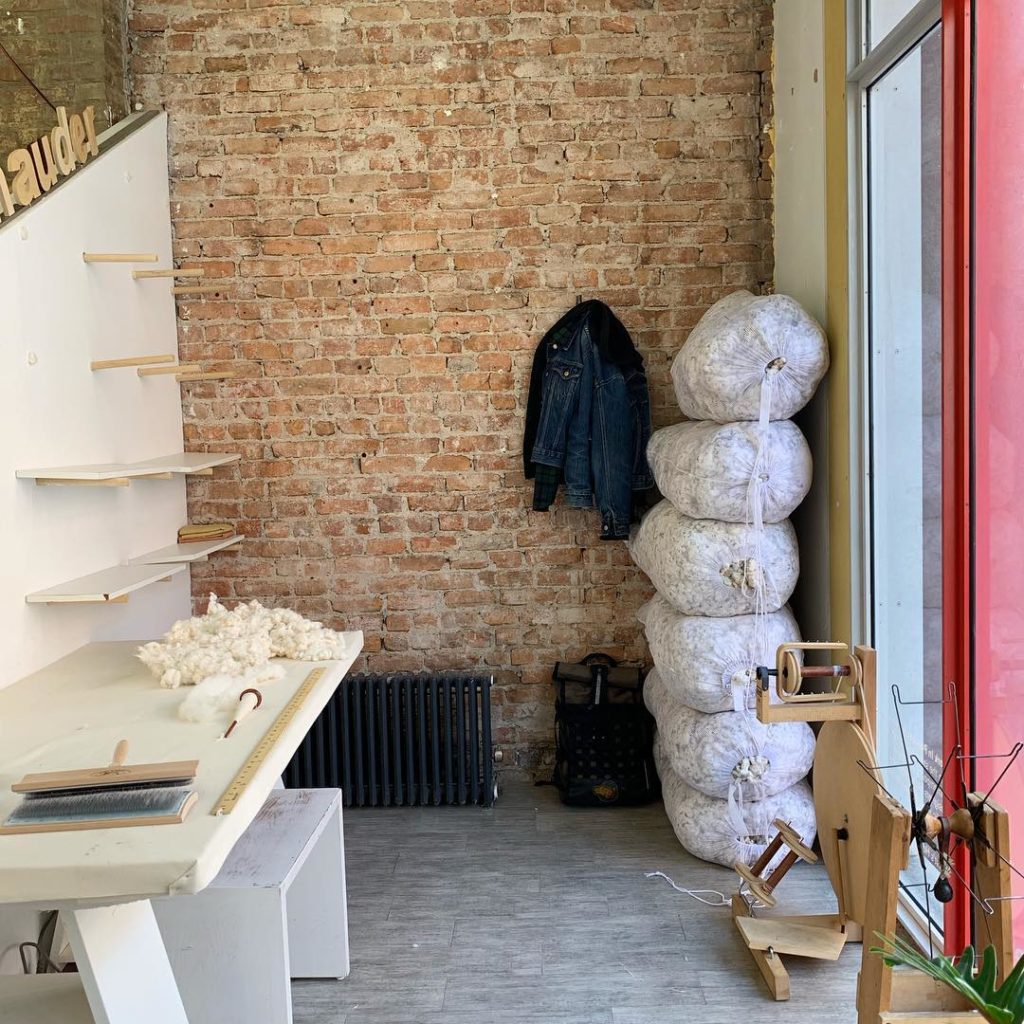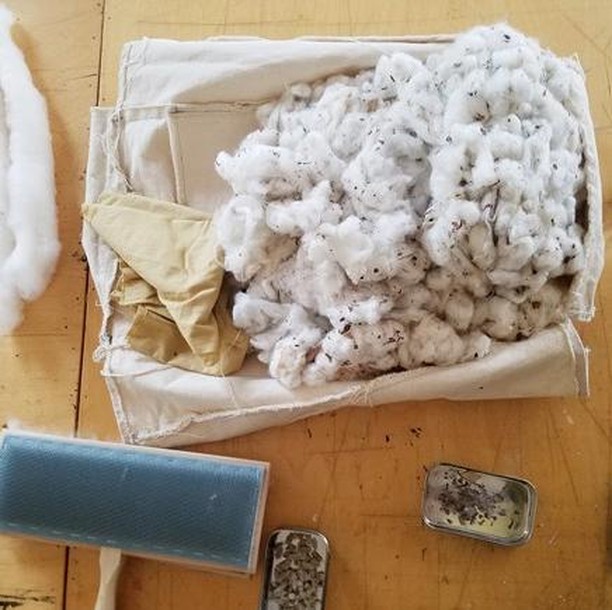WIP Artist Highlight: Kendall Schauder
It is hard to describe the enjoyment and immediate kinship you find when a Texan meets another Texan, especially when it is unexpected. Kendall Schauder is a Houston, Texas native, now living and working in Chicago. She moved to attend The School of the Art Institute of Chicago, graduating with a Bachelor of Fine Arts in 2017.
In a class, she was given leftover indigo seedlings, which then flourished in her apartment. From this, she was able to harvest her own indigo seeds. Indigo quickly brings denim to mind, creating the base for Kendall’s current project, How to Grow Denim.

Cotton fields dot the trip down the coast from Houston to Corpus Christi, Texas, where Kendall’s brother lives. He had been telling her to come down there, that cotton from the fields blow across the road. But then Hurricane Harvey hit the coast of Texas at the end of August, 2017. This is cotton harvesting and gin time in Texas, and while many were able to harvest their cotton before the storm, this was not the case for all farmers. Even if it was harvested, many had not made it to the gin, and the gins had not finished processing all of the recently delivered cotton. This left cotton out in the fields, covered with tarps. Kendall read an article about one of the gins between Houston and Corpus Christi and how a lot of their cotton was unsalvageable from the rainwater and flooding. When she went home for Thanksgiving that fall she gave them a call and asked if they still had the cotton they can’t use, could she have some. They said yes, in fact, they still have tons sitting in their field.
“So I drove, stayed with my brother for a night, borrowed my dad’s pickup truck and went to the cotton gin. There were just piles. All of the fields were just covered with damp piles of cotton, taller than my head. I can’t even fathom this much material and they were just going to have to throw it away. They didn’t know what to do with it at that point. They just had it sitting there. They went through it to see what they might be able to salvage so they took what they could, but then there’s just piles of what was not possible.”
Kendall filled the pickup from the bed to the front seat full trash bags of cotton, assisted by a couple of men from the mill. She has six of the bags with her here at TAC, and another 16 back in her parents’ garage. Eventually, it will be turned into a 40 yard bolt of denim, woven during a sculptural installation that is still being realized. Currently, Kendall plans on creating a vertical wall mounted loom that is warp weighted that she will interact with and weave on. The denim will become the tensioner on the ground, pooling at the bottom of the loom.

During her residency at TAC, Kendall is spinning the fiber she’s carding from the salvaged cotton. She hasn’t spun before and is experimenting with both a drop spindle and spinning wheel. Instead of reading books on spinning, Kendall is learning with her hands. Art school opened up the ability to learn by doing, to try out different paths, to follow where her interests took her. Diagnosed with dyslexia, school was difficult to the point where Kendall would hide in her room to avoid going, worried that she was not good enough to participate in class.
“Basically how I see that in my work now is me trying to find what I wanted as a child. That kind of way of learning that is just following a natural curiosity. In this project, I’ve never spun cotton before, I’ve never made my own indigo vat but it’s just through wanting to do something. I’m having to take pieces of it and not necessarily read a whole book on how to spin yarn. I’m interacting with the material that I have here and trying to make it do something that I want it to do. Figuring out my own way of learning and what is productive for me. It’s something that I wish I could’ve had more in education. To just know it’s not the fact that I don’t want to retain information, just the way it is received is different.”
Working in the window at the TAC Manhattan studio has proved to be serendipitous. One day a woman walked by, did a double take and then came in. She nannies in the area and saw Kendall spinning in the window. She was surprised to see someone spinning yarn and came in to chat. She had grown up spinning with her mother in Tibet and was able to show Kendall a softer way to hold the spindle so that her hand would not cramp. This completely changed the experience of spinning, and would not have happened without this very specific workspace. It is a sort of performance in both ways. People are participating in Kendall’s practice, and she is participating in their lives as well. She likes the idea of people seeing it at different stages, showing the slow development of her work. On the other side, Kendall loves seeing the small progression in people’s lives as they walk by every day.
The moment with the woman is reminiscent of a scene from an audiobook Kendall is listening to right now- Cræft: An Inquiry Into the Origins and True Meaning of Traditional Crafts by Alexander Langlands. In the introduction, Langlands has difficulty with his mechanical strimmer so decides to use a scythe that he had purchased years earlier. An older man driving by stopped, and while laughing, came to show him how to use the scythe. He sharpened the edge and demonstrated the proper technique. It only took a little longer to cut it by hand than it would have with his strimmer. He continued to use the scythe throughout the summer, enjoying how it physically changed the shape of his garden and being able to hear birds while working. “As autumn reached for her golden grown, I realised that I’d taken a traditional way of doing something and found that, on my terms, it was just as effective as the mechanically charged, petrol-powered methods of today.” (pg.5)
In spinning, Kendall is finding another similar relationship to Langland’s experiences. While she assumed she would primarily use a spinning wheel, she now prefers using a drop spindle. The spinning wheel has its own rhythm and even though this is set by the spinner, there is a limit to how slow it will go. It pulls back, forcing you to go with it as it takes the yarn. The spindle is just as quick as the spinning wheel and offers a sense of full control. Now that she has learned the proper technique from the woman walking by, Kendall’s hand does not cramp while spinning with the drop spindle for a long time.
The spinning wheel has its own rhythm and even though this is set by the spinner, there is a limit to how slow it will go. It pulls back, forcing you to go with it as it takes the yarn.
Later this month Kendall will be holding a sold-out workshop for youth where she will be teaching the cotton cleaning through spinning process. The spindles will the DIY, out of found objects like CDs and pencils and can be taken home after the workshop. She will also be holding open studio every Saturday this month from 2pm-5pm at the Manhattan studio.
“I think especially really realizing how much I like drop spindle spinning now, I am even more excited to teach the workshop. Teach them how to use it and how the spin is actually the thing that’s creating the yarn. They can also take it home with them and experiment and figure out how they want to do it, find their own speed with it, as fast or slow that they need.”